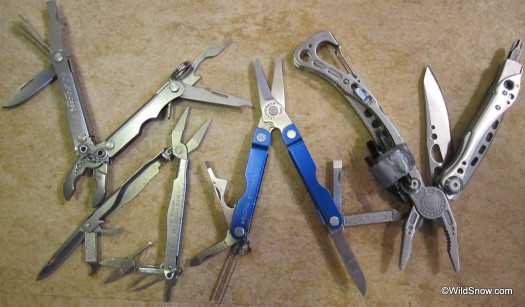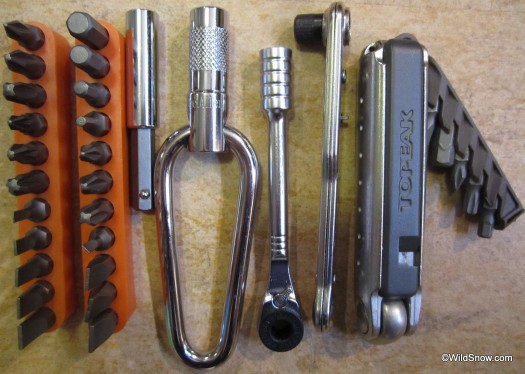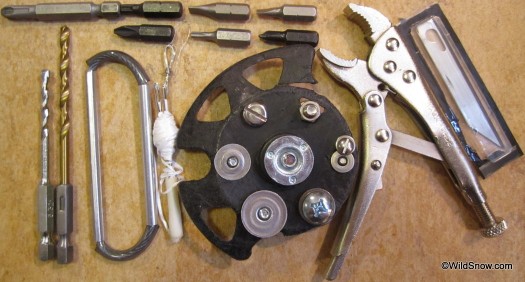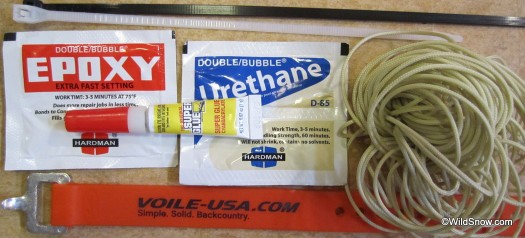How prepared should you be for backcountry gear failure? Let’s say that out of 100 ski tours, on only one of them will you ever need that kit-that-fixes-anything. Without the toolbox, you’ll have to hike out, arriving tired, hungry, and dehydrated back at the trailhead in the dark (provided you’re prepared with certain of the variously defined Ten Essentials, such as a light source and a bit of extra food). Not much fun. But then again, is avoiding that misery worth lugging all that repair gear for the other 99 trips on which the gear isn’t needed?
Your answer depends on the trip. If your plan is for a long multi-day traverse, then being stranded with broken gear halfway through isn’t a risk worth taking. Or a long approach to set up a basecamp for subsequent daytrips is going to be a big disappointment with broken gear, plus the repair kit can stay at basecamp anyway. And even for a daytrip, if the tour route requires a long skin back up through unconsolidated snow, then postholing goes beyond mere misery and into the danger zone. By contrast, even for an ambitious ski mountaineering trip in the spring or summer, being unable to ski and hence forced to downclimb just puts you in the same miserable category as all the many non-skiing climbers on the route.
Many other possibilities are imaginable as are many potential gear repair kits. The following pictures and descriptions are various items I’ve accumulated over the years, although most of them never leave home these days, and few of the items taken out skiing have ever been used for anything. The idea here is to simply stimulate thought and discussion about this all important subject.
First, some multi-tools, as shown below.
This is of course a huge market, with a seemingly endless array of options. In the picture, at the bottom left, is a Buck Model 350 Minibuck Tool. Weighing in at only a mere ounce, the 350 is so small that I can keep it a little wallet-type pouch with many other items in my back pocket. Long-since discontinued, it seems to regularly show up used on eBay.
At the top left is a two-ounce SOG CrossGrip which unfortunately is also long-since discontinued, yet is notable for the impressive leverage of the pliers on such a small and light tool. In the middle is a two-ounce Leatherman Micra although the similar PS4 (not shown) would probably be more useful with both scissors and pliers. To the right is a Leatherman Skeletool weighing in at five-and-a-half ounces as pictured with a whopping dozen different drive bits. The knife and pliers have a very solid feel, and all aspects of the entire tool feel very well designed and produced. The only catch is that the weight savings derive in part from a non-standard bit holder, so you have to spring for the extra bit kit (which yes, includes a pozi #3). Brooks-Range has attempted to produce a very similar full-service yet lightweight tool that works with standard bits, as Lou previously reviewed (but has been discontinued due to problems with manufacturing quality control).
What if your main concern is bit driving? I’ve found some interesting options for lightweight backcountry drivers.
On the left, hailing from the unlikely ski gear source of Texas, is “Doc Allen’s” Versa Tool, which includes 22 standard bits (including pozi #3), a standard bit extender, and a 2.4-ounce driver that provides outstanding leverage and grip in several configurations. To the right of that is the one-ounce ratchet part of the Topeak Ratchet Rocket. Leaving out the bike-specific parts (not shown), you get a bare-bones yet fairly solid-feeling driver, with ratcheting action and great leverage when using the black part at the bottom, or extended reach when using the part at the top. To the right is a similar tool from a hardware store (although no extended reach position), and to the far right is a Topeak ToolBar which would be really nice if the foreshortened bits were available in a ski-specific version. If you’re really focused on bit driving, then you can go all out for that ratcheting driver with the very nice ergonomic grip that’s been around for a couple decades or so, most recently from BD, Dakine, and now also Brooks-Range. (Not pictured here since I consider it more of a workbench item.)
Even more tools? Of course!
To the far left are hex-driven 5/32″ drill bits, weighing in at less than half an ounce each. The silver-colored bit is widely available at Home Depot, but has a masonry tip that might be hard to get started in a ski. The gold-colored is from Harbor Freight, and available only in a large kit, although like everything else there is still really cheap. (I doubt you’d want to use their bits for extended use, but I’m confident that it would hold up to manual driving.) Then a spare tip loop (in case some fancy proprietary skin tip attachment fails), a couple large heavy-duty sewing needles with Glide dental floss, some very fine wire to clean clogged stove parts, a spare BD pole basket with various screw rivets attached, and at top an assortment of bits. Note in particular the extended #3 Pozidrive bit for accessing difficult-to-access screw heads. I’ve found Wiha Tools to be an excellent source for these extended bits, in a variety of sizes.
At far right is a miniature pair of visegrip-style pliers. At over three ounces, kind of overkill by themselves. But combined with a Stanley blade (as shown), and all those bits, that could be a capable all-in-one tool.
Anything else? Of course — how about a few things to attach various things to other things.
This is another category that could go on forever, but at top are some zip/cable ties, at bottom a Voile strap (be sure to spring for the metal tip, as it’s probably more durable but most certainly is excellent for cleaning out the tech fittings in your boots), to the right some lightweight cord, and to the left some epoxy, urethane, and glue.
Okay, that’s enough for now — out to recreate in the backcountry, taking almost none of all this! Want to shout out to your favorite repair items? Let’s hear it…
(WildSnow guest blogger Jonathan Shefftz lives with his wife and daughter in Western Massachusetts, where he is a member of the Northfield Mountain and Thunderbolt / Mt Greylock ski patrols. Formerly an NCAA alpine race coach, he has broken free from his prior dependence on mechanized ascension to become far more enamored of self-propelled forms of skiing.)
WildSnow guest blogger Jonathan Shefftz lives with his wife and daughter in Western Massachusetts, where he is a member of the Northfield Mountain and Thunderbolt (Mt. Greylock) ski patrols. Formerly an NCAA alpine race coach, he has broken free from his prior dependence on mechanized ascension to become far more enamored of self-propelled forms of skiing. He is an AIARE-qualified instructor, NSP avalanche safety instructor, and contributor to the American Avalanche Association’s The Avalanche Review. When he is not searching out elusive freshies in Southern New England, he works as a financial economics consultant.




